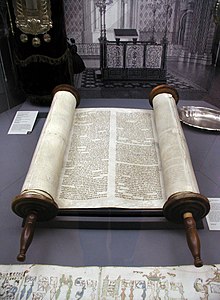Mathematics of the Jewish Calendar/The Annual Cycle of Torah Readings
A section of the Torah is read every Shabbat morning. The universal custom nowadays among orthodox Jews is to read through the entire Torah once a year. The first section (Bereshit) is read on the Shabbat after Simchat Torah, and the last (Vezot Habracha) is read on Simchat Torah, the only time a regular section is read on a weekday. (In Israel, Simchat Torah can sometimes fall on a Shabbat; elsewhere, where it is a day later, it is always a weekday.)

There are special readings, outside the annual cycle, for the various festivals and fasts. If a festival (including Shabbat Chol Hamoed) falls on Shabbat, its reading supersedes the weekly one, which is postponed for a week (or possibly two if the first and eighth days of Pesach or Succot are both Shabbat).
Sometimes, there is a second Torah reading after the main one. On Shabbat and some festivals and fasts, there is a Haftara (reading from the Prophets) after the Torah reading. However, details of these are beyond the scope of this book.
The correct term for a weekly section is a parasha. A widely used alternative term is sidra, though strictly this is the name for one of the smaller sections used in the now obsolete custom of taking three years to read through the whole Torah.
Considering all of the 14 possible year types, there is a need for at least 48 and at most 54 sections in a year. The Torah is therefore divided into 54 sections, of which twelve are in six pairs, and when necessary a pair of sections (a double parasha or double sidra) is read on the same Shabbat.
If the eighth day of Pesach or the second day of Shavuot (outside Israel) fall on a Saturday, they will not be festival days in Israel. Thus, for a few weeks, there will be a difference between the sections read in Israel and elsewhere. (This does not apply to Succot, since the extra festival day outside Israel is always a weekday.)
When are sections doubled?
editThe following rules decide which pairs are read on the same day and which are not:
- No sections are doubled before the month of Adar; this may date back to the time before the rules for determining leap years were fixed.
- In an ordinary year, we combine four pairs that are not combined in a leap year:
- Vayakhel/Pekude
- Tazria/Metsora
- Achare Mot/Kedoshim
- Behar/Bechukotai
Vayakhel/Pekude is not doubled in year type 5; in Israel, Behar/Bechukotai is not doubled in year type 4.
- The section Devarim must always be read on the Shabbat before the fast of Tisha b'Av. If 9th Av is a Shabbat, Devarim is read on that day and the fast is postponed. Two rules are necessary to ensure this.
- When 1st day Shavuot falls on Friday (i.e. 1st day Pesach on Thursday, next 1st day Rosh Hashana on Saturday), Chukkas/Balak are combined, otherwise they are separate.
- Normally, Naso is read on the Shabbat after Shavuot. However, in leap years, if the previous Rosh Hashana was on Thursday, Naso is read on the Shabbat before Shavuot. Thus in such years, Mattot and Masse are not doubled.
- The section Nitzavim is always read on the Shabbat before Rosh Hashana. Following that, there are only three more sections: Vayelech, Ha'azinu and Vezot Habracha. The last of these is read in Simchat Torah. If Rosh Hashana or Yom Kippur is Shabbat, their special readings supersede the annual cycle. There is always one Shabbat between Rosh Hashana and Yom Kippur when a section can be read. If the first day of Rosh Hashana is a Monday or Tuesday, there is a Shabbat between Yom Kippur and Succot; Ha'azinu is read then, and Vayelech before Yom Kippur. However, if the first day of Rosh Hashana is a Thursday or Saturday, there is no Shabbat between Yom Kippur and Succot; Ha'azinu must be read before Yom Kippur; Vayelech as well as Nitzavim must be read before Rosh Hashana.
Rules in Israel
editAs noted above, the absence of second day Yom Tov in Israel means that sometimes the readings differ between Israel and elsewhere.
- If the 1st day of Pesach is Saturday, the next Saturday is not Yom Tov in Israel so there is an extra week.
- In an ordinary year, in Israel Behar and Bechukotai are not doubled.
- In a leap year, Naso is read before Shavuot in Israel and Mattot and Masse are not doubled.
- If the 1st day of Shavuot is Friday, the next day, Saturday, is not Yom Tov in Israel so again there is an extra week. The usual practice is that Chukkat and Balak are not doubled. This means that these sidras are never doubled in any year. There is an alternative custom not to double Mattot and Masse.
All possible doublings and no doublings
editThus, outside Israel, all seven pairs of sidras are doubled in year types 2 and 3; none is doubled in year type 11. (The last year type 11 was 5768; the next is 5812.) A type 11 year is always followed by a type 3 year, which has all seven doubles.
In Israel, there cannot be more than six double sidras since Chukkas/Balak is never doubled. All six pairs of sidras are doubled in year types 1, 2, 3 and 6; none is doubled in year types 9, 10 and 11.
For reasons beyond the scope of this book, the haftara for Pinchas is only read when Mattot and Masse are not doubled (otherwise the haftara of Mattot is read with Pinchas). This only happens in year types 11 and 12 (except in those communities in Israel that divide mattot-Masse rather than Chukkat-Balak). There are runs of 23 consecutive years when it is not said, for example 5593-5615, 5924-5946.